|
|
The Palace in Đồng Văn District
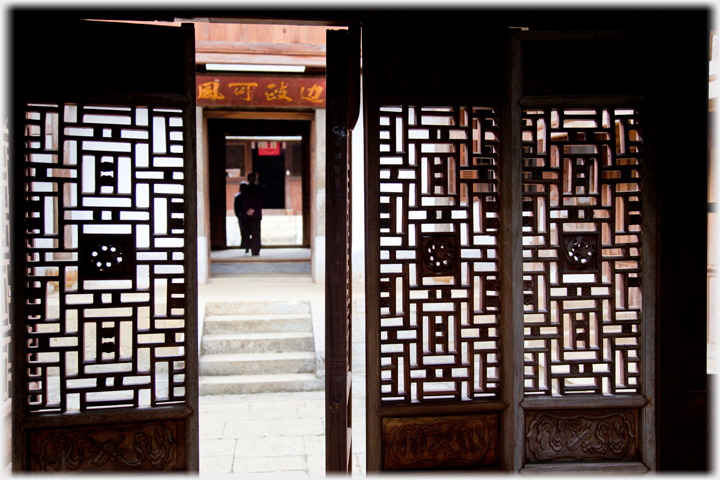 The door screens at the entrance to the palace
The door screens at the entrance to the palace
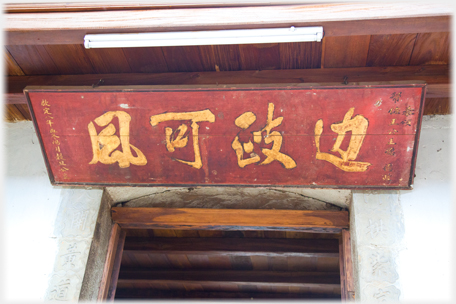 The Plaque above the door is in Chinese, as opaque to modern Vietnamese as to westerners
The Plaque above the door is in Chinese, as opaque to modern Vietnamese as to westerners
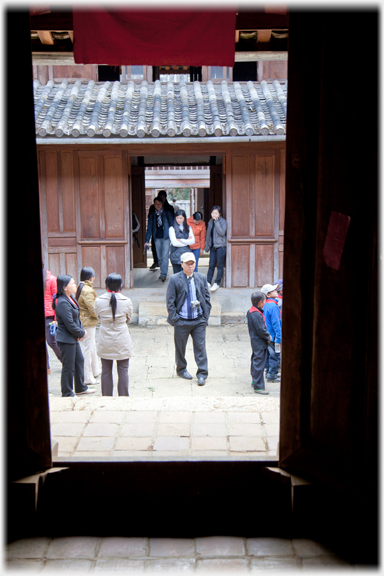 The first of the two courtyards with the steady trickle of visitors who reach these far parts
The Palace is about 10 miles (15 km) south-west of the town of Đồng Văn. It was built in 1914 when the French saw the advantage of having a buffer between their rule of occupation in Vietnam and the Chinese Empire. It is a delightful, simple complex befitting the remoteness of its location. There is a
second page on the Palace.
More
on another site.
The first of the two courtyards with the steady trickle of visitors who reach these far parts
The Palace is about 10 miles (15 km) south-west of the town of Đồng Văn. It was built in 1914 when the French saw the advantage of having a buffer between their rule of occupation in Vietnam and the Chinese Empire. It is a delightful, simple complex befitting the remoteness of its location. There is a
second page on the Palace.
More
on another site.
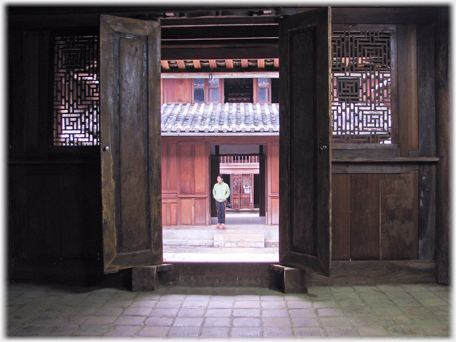 View back towards entrance
View back towards entrance
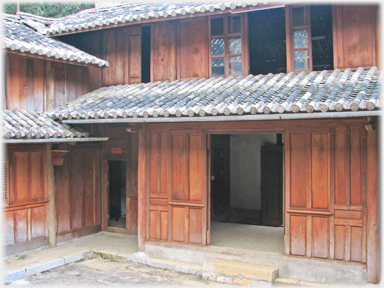 A corner of the inner courtyard
A corner of the inner courtyard
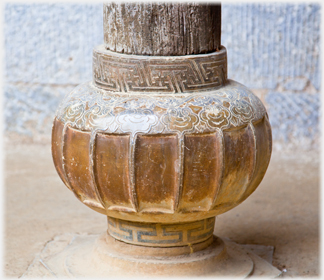 The base of one of the wooden posts
The base of one of the wooden posts
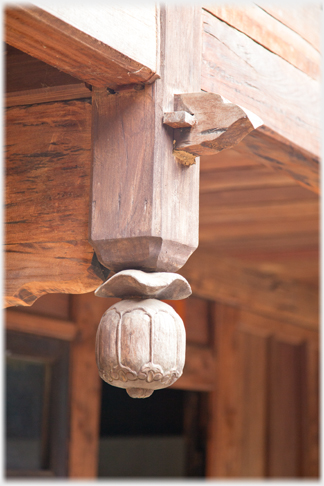 The decorated balustrade posts protrude below the balcony
The decorated balustrade posts protrude below the balcony
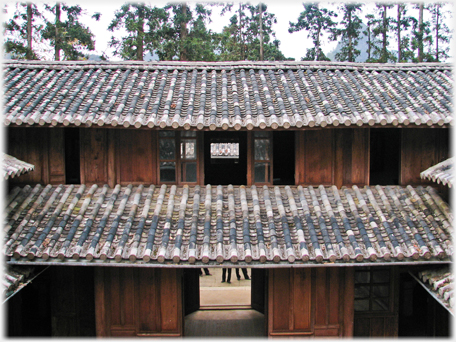 The roofs sit tightly down onto the building
The Palace took 8 years to construct using workers from Yunnan Province in China to create the many fine details of carving and woodwork. The cost was 150,000 silver coins, about $7.5 million today, money which seems likely to have come from the active opium trade of the period. Poppies figure prominently in the carvings!
The roofs sit tightly down onto the building
The Palace took 8 years to construct using workers from Yunnan Province in China to create the many fine details of carving and woodwork. The cost was 150,000 silver coins, about $7.5 million today, money which seems likely to have come from the active opium trade of the period. Poppies figure prominently in the carvings!
 The ends of the roof posts are carved
The ends of the roof posts are carved
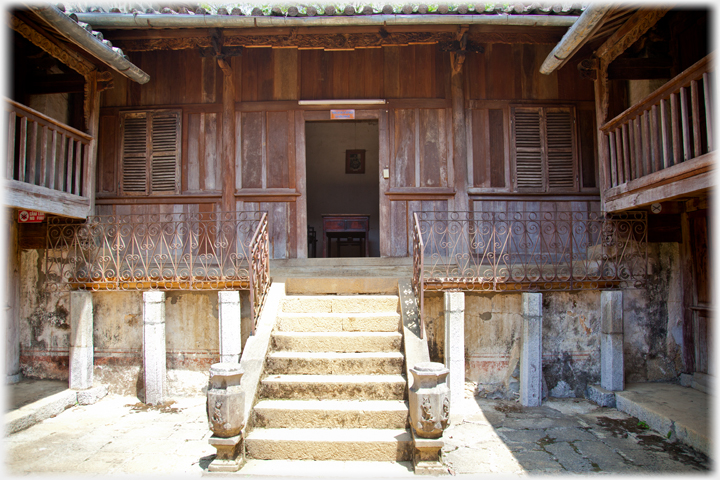 The inner courtyard leads up to what were the private quarters of the king
The inner courtyard leads up to what were the private quarters of the king
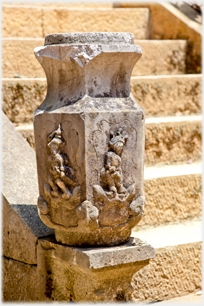 A detail from the picture above
A detail from the picture above
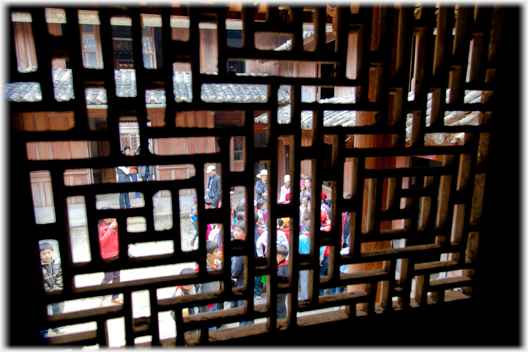 Screens shield the rooms on the upper floor. Looking down into the entry courtyard
On visiting the palace you are likely to be shown around by one of the surviving grandchildren, who still live nearby.
Screens shield the rooms on the upper floor. Looking down into the entry courtyard
On visiting the palace you are likely to be shown around by one of the surviving grandchildren, who still live nearby.
 A teacher explains the history to (most of) the visiting children, strange foreigners are, as everywhere, more interesting for some
A teacher explains the history to (most of) the visiting children, strange foreigners are, as everywhere, more interesting for some
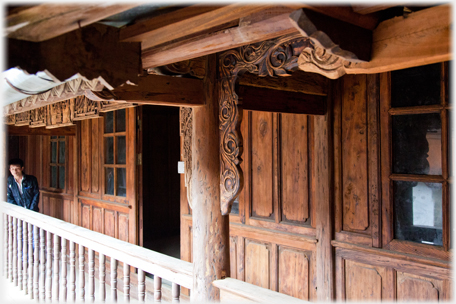 One of the galleries with its carved roof supports
One of the galleries with its carved roof supports
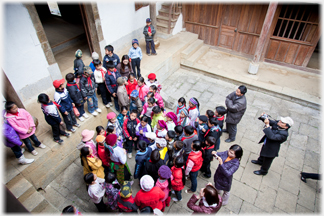 The school party is itself a subject of photography
The school party is itself a subject of photography
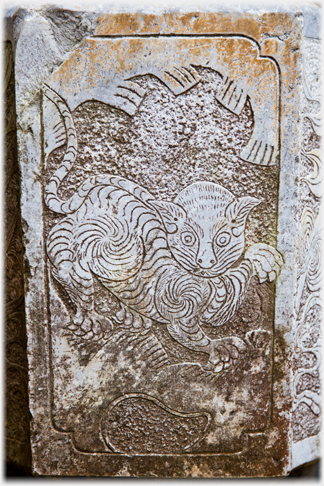 One of the bas-relief foots of the columns
The palace complex was created by Vương Chinh Đức, known as Vua Mèo - king of the H'Mong; he and his three wives and their four sons lived there until he died in 1947.
One of the bas-relief foots of the columns
The palace complex was created by Vương Chinh Đức, known as Vua Mèo - king of the H'Mong; he and his three wives and their four sons lived there until he died in 1947.
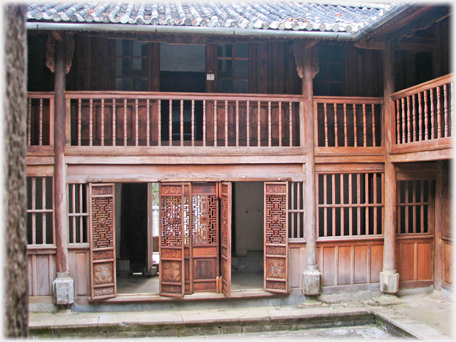 The inner courtyard around which are the rooms of the family
The inner courtyard around which are the rooms of the family
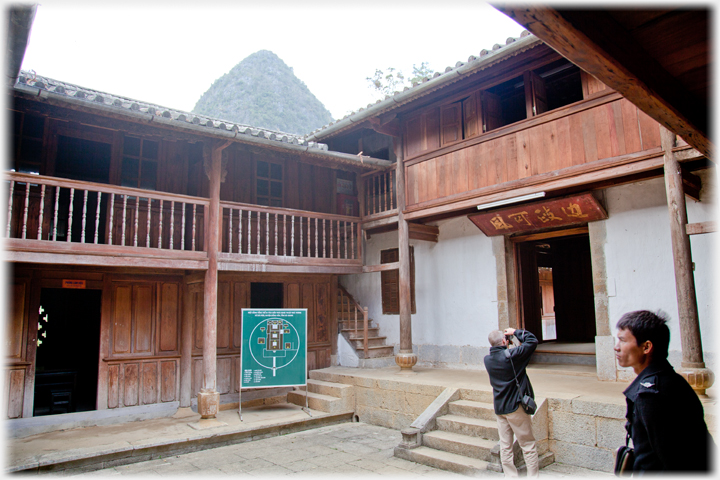 The outer courtyard with a karst peeping over the roof
The next page shows, in comparison and contrast, the 'house' of the wealthiest family of the fifteen hundreds in Kirkcudbright, in south-west Scotland, which stands at one end of St. Cuthbert's Street.
The outer courtyard with a karst peeping over the roof
The next page shows, in comparison and contrast, the 'house' of the wealthiest family of the fifteen hundreds in Kirkcudbright, in south-west Scotland, which stands at one end of St. Cuthbert's Street.
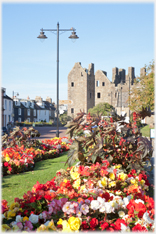

Saturday 26th November 2016

Go to the Picture Posting contents page
Return to the top
|
|
 The door screens at the entrance to the palace
The door screens at the entrance to the palace
 The Plaque above the door is in Chinese, as opaque to modern Vietnamese as to westerners
The Plaque above the door is in Chinese, as opaque to modern Vietnamese as to westerners
 The first of the two courtyards with the steady trickle of visitors who reach these far parts
The Palace is about 10 miles (15 km) south-west of the town of Đồng Văn. It was built in 1914 when the French saw the advantage of having a buffer between their rule of occupation in Vietnam and the Chinese Empire. It is a delightful, simple complex befitting the remoteness of its location. There is a
second page on the Palace.
More
on another site.
The first of the two courtyards with the steady trickle of visitors who reach these far parts
The Palace is about 10 miles (15 km) south-west of the town of Đồng Văn. It was built in 1914 when the French saw the advantage of having a buffer between their rule of occupation in Vietnam and the Chinese Empire. It is a delightful, simple complex befitting the remoteness of its location. There is a
second page on the Palace.
More
on another site.
 View back towards entrance
View back towards entrance
 A corner of the inner courtyard
A corner of the inner courtyard
 The base of one of the wooden posts
The base of one of the wooden posts
 The decorated balustrade posts protrude below the balcony
The decorated balustrade posts protrude below the balcony
 The roofs sit tightly down onto the building
The Palace took 8 years to construct using workers from Yunnan Province in China to create the many fine details of carving and woodwork. The cost was 150,000 silver coins, about $7.5 million today, money which seems likely to have come from the active opium trade of the period. Poppies figure prominently in the carvings!
The roofs sit tightly down onto the building
The Palace took 8 years to construct using workers from Yunnan Province in China to create the many fine details of carving and woodwork. The cost was 150,000 silver coins, about $7.5 million today, money which seems likely to have come from the active opium trade of the period. Poppies figure prominently in the carvings!
 The ends of the roof posts are carved
The ends of the roof posts are carved
 The inner courtyard leads up to what were the private quarters of the king
The inner courtyard leads up to what were the private quarters of the king
 A detail from the picture above
A detail from the picture above
 Screens shield the rooms on the upper floor. Looking down into the entry courtyard
On visiting the palace you are likely to be shown around by one of the surviving grandchildren, who still live nearby.
Screens shield the rooms on the upper floor. Looking down into the entry courtyard
On visiting the palace you are likely to be shown around by one of the surviving grandchildren, who still live nearby.
 A teacher explains the history to (most of) the visiting children, strange foreigners are, as everywhere, more interesting for some
A teacher explains the history to (most of) the visiting children, strange foreigners are, as everywhere, more interesting for some
 One of the galleries with its carved roof supports
One of the galleries with its carved roof supports
 The school party is itself a subject of photography
The school party is itself a subject of photography
 One of the bas-relief foots of the columns
The palace complex was created by Vương Chinh Đức, known as Vua Mèo - king of the H'Mong; he and his three wives and their four sons lived there until he died in 1947.
One of the bas-relief foots of the columns
The palace complex was created by Vương Chinh Đức, known as Vua Mèo - king of the H'Mong; he and his three wives and their four sons lived there until he died in 1947.
 The inner courtyard around which are the rooms of the family
The inner courtyard around which are the rooms of the family
 The outer courtyard with a karst peeping over the roof
The next page shows, in comparison and contrast, the 'house' of the wealthiest family of the fifteen hundreds in Kirkcudbright, in south-west Scotland, which stands at one end of St. Cuthbert's Street.
The outer courtyard with a karst peeping over the roof
The next page shows, in comparison and contrast, the 'house' of the wealthiest family of the fifteen hundreds in Kirkcudbright, in south-west Scotland, which stands at one end of St. Cuthbert's Street.


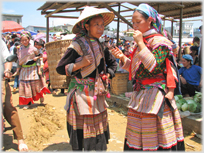 The last page was about customers at the Bắc Hà market
The last page was about customers at the Bắc Hà market
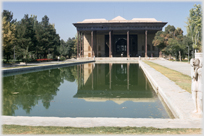 A page on Isfahan including a rather grander palace
A page on Isfahan including a rather grander palace
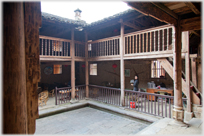 A page about the cafe in Đồng Văn which is arranged, like the palace, around a courtyard
A page about the cafe in Đồng Văn which is arranged, like the palace, around a courtyard
